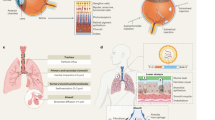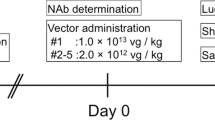Abstract
The development of safe and efficient liver-specific gene delivery approaches offers new perspectives for the treatment of liver disease, in particular, liver cancer. We evaluated the therapeutic potential of hepatotropic nanoparticles for gene therapy of liver tumor. These nanoparticles do not contain a viral genome and display the hepatitis B virus L antigen, which is essential to confer hepatic specificity. It has not been shown whether a therapeutic effect could be obtained using L nanoparticles in a human liver tumor xenograft model. Rats bearing human hepatic (NuE) and non-hepatic tumors were injected with L nanoparticles containing a green fluorescent protein (GFP) expression plasmid. GFP expression was observed only in NuE-derived tumors but not in the non-hepatic tumor. The potential for treatment of liver tumors was analyzed using L nanoparticles containing the herpes simplex virus thymidine kinase gene, in conjunction with ganciclovir pro-drug administration. The growth of NuE-derived tumors in L particle-injected rats was significantly suppressed, but not of the non-hepatic tumor control. In summary, this is the first demonstration that nanoparticles could be used for delivery of therapeutic genes with anti-tumor activity into human liver tumors. This intravenous delivery system may be one of the major advantages as compared to many other viral vector systems.
This is a preview of subscription content, access via your institution
Access options
Subscribe to this journal
Receive 12 print issues and online access
$259.00 per year
only $21.58 per issue
Buy this article
- Purchase on Springer Link
- Instant access to full article PDF
Prices may be subject to local taxes which are calculated during checkout




Similar content being viewed by others
References
Friedmann T . Human gene therapy – an immature genie, but certainly out of the bottle. Nat Med 1996; 2: 144–147.
Verma IM, Somia N . Gene therapy – promises, problems and prospects. Nature 1997; 389: 239–242.
Connors TA . The choice of prodrugs for gene directed enzyme prodrug therapy of cancer. Gene Therapy 1995; 2: 702–709.
Sandmair AM, Loimas S, Puranen P, Immonen A, Kossila M, Puranen M et al. Thymidine kinase gene therapy for human malignant glioma, using replication-deficient retroviruses or adenoviruses. Hum Gene Ther 2000; 11: 2197–2205.
Ram Z, Culver KW, Oshiro EM, Viola JJ, DeVroom HL, Otto E et al. Therapy of malignant brain tumors by intratumoral implantation of retroviral vector-producing cells. Nat Med 1997; 3: 1354–1361.
Morris JC, Wildner O . Therapy of head and neck squamous cell carcinoma with an oncolytic adenovirus expressing HSV-tk. Mol Ther 2000; 1: 56–62.
Okabe S, Arai T, Yamashita H, Sugihara K . Adenovirus-mediated prodrug-enzyme therapy for CEA-producing colorectal cancer cells. J Cancer Res Clin Oncol 2003; 129: 367–373.
Loimas S, Toppinen MR, Visakorpi T, Janne J, Wahlfors J . Human prostate carcinoma cells as targets for herpes simplex virus thymidine kinase-mediated suicide gene therapy. Cancer Gene Ther 2001; 8: 137–144.
Okuda K . Hepatocellular carcinoma. J Hepatol 2000; 32: 225–237.
Lau WY . Primary liver tumors. Semin Surg Oncol 2000; 19: 135–144.
Ruiz J, Qian C, Drozdzik M, Prieto J . Gene therapy of viral hepatitis and hepatocellular carcinoma. J Viral Hepat 1999; 6: 17–34.
Qian C, Drozdzik M, Caselmann WH, Prieto J . The potential of gene therapy in the treatment of hepatocellular carcinoma. J Hepatol 2000; 32: 344–351.
Gao Ding C, An W, Dai J . Retrovirus-mediated herpes simplex virus thymidine kinase gene therapy approach for hepatocellular carcinoma. Cell Res 1999; 9: 225–235.
Su H, Lu R, Ding R, Kan YW . Adeno-associated viral-mediated gene transfer to hepatoma: thymidine kinase/interleukin 2 is more effective in tumor killing in non-ganciclovir (GCV)-treated than in GCV-treated animals. Mol Ther 2000; 1: 509–515.
Tsuchiyama T, Kaneko S, Nakamoto Y, Sakai Y, Honda M, Mukaida N et al. Enhanced antitumor effects of a bicistronic adenovirus vector expressing both herpes simplex virus thymidine kinase and monocyte chemoattractant protein-1 against hepatocellular carcinoma. Cancer Gene Ther 2003; 10: 260–269.
Gerolami R, Uch R, Faivre J, Garcia S, Hardwigsen J, Cardoso J et al. Herpes simplex virus thymidine kinase-mediated suicide gene therapy for hepatocellular carcinoma using HIV-1-derived lentiviral vectors. J Hepatol 2004; 40: 291–297.
Cao G, Kuriyama S, Gao J, Mitoro A, Cui L, Nagao S et al. In vivo gene transfer of a suicide gene under the transcriptional control of the carcinoembryonic antigen promoter results in bone marrow transduction but can avoid bone marrow suppression. Int J Oncol 1999; 15: 107–112.
VandenDriessche T, Thorrez L, Naldini L, Follenzi A, Moons L, Berneman Z et al. Lentiviral vectors containing the human immunodeficiency virus type-1 central polypurine tract can efficiently transduce nondividing hepatocytes and antigen-presenting cells in vivo. Blood 2002; 100: 813–822.
Yamada T, Iwasaki Y, Tada H, Iwabuki H, Chuah MK, VandenDriessche T et al. Nanoparticles for the delivery of genes and drugs to human hepatocytes. Nat Biotechnol 2003; 21: 885–890.
Kuroda S, Otaka S, Miyazaki T, Nakao M, Fujisawa Y . Hepatitis B virus envelope L protein particles. Synthesis and assembly in Saccharomyces cerevisiae, purification and characterization. J Biol Chem 1992; 267: 1953–1961.
Yu D, Amano C, Fukuda T, Yamada T, Kuroda S, Tanizawa K et al. The specific delivery of proteins to human liver cells by engineered bio-nanocapsules. FEBS J 2005; 272: 3651–3660.
Yamada T, Iwabuki H, Kanno T, Tanaka H, Kawai T, Fukuda H et al. Physicochemical and immunological characterization of hepatitis B virus envelope particles exclusively consisting of the entire L (pre-S1 + pre-S2 + S) protein. Vaccine 2001; 19: 3154–3163.
Merten OW, Cruz PE, Rochette C, Geny-Fiamma C, Bouquet C, Goncalves D et al. Comparison of different bioreactor systems for the production of high titer retroviral vectors. Biotechnol Prog 2001; 17: 326–335.
Snyder RO, Flotte TR . Production of clinical-grade recombinant adeno-associated virus vectors. Curr Opin Biotechnol 2002; 13: 418–423.
Hosokawa S, Muramatsu M, Nagaike K . Detection of membrane-bound alpha-fetoprotein in human hepatoma cell lines by monoclonal antibody 19F12. Cancer Res 1989; 49: 361–366.
Inouye S, Ogawa H, Yasuda K, Umesono K, Tsuji FI . A bacterial cloning vector using a mutated Aequorea green fluorescent protein as an indicator. Gene 1997; 189: 159–162.
Carlsson G, Gullberg B, Hafstrom L . Estimation of liver tumor volume using different formulas - an experimental study in rats. J Cancer Res Clin Oncol 1983; 105: 20–23.
Kamovsky MJ . A formaldehyde-glutaraldehyde fixation of high osmolality for use in electron microscopy. J Cell Biol 1965; 2: 137A–138A.
Neurath AR, Kent SB, Strick N, Parker K . Identification and chemical synthesis of a host cell receptor binding site on hepatitis B virus. Cell 1986; 46: 429–436.
Barker LF, Maynard JE, Purcell RH, Hoofnagle JH, Berquist KR, London WT . Viral hepatitis, type B, in experimental animals. Am J Med Sci 1975; 270: 189–195.
Gong ZJ, De Meyer S, van Pelt J, Hertogs K, Depla E, Soumillion A et al. Transfection of a rat hepatoma cell line with a construct expressing human liver annexin V confers susceptibility to hepatitis B virus infection. Hepatology 1999; 29: 576–584.
Moore PL, Ong S, Harrison TJ . Squamous cell carcinoma antigen 1-mediated binding of hepatitis B virus to hepatocytes does not involve the hepatic serpin clearance system. J Biol Chem 2003; 278: 46709–46717.
VandenDriessche T, Collen D, Chuah MK . Biosafety of onco-retroviral vectors. Curr Gene Ther 2003; 3: 501–515.
Caruso M, Panis Y, Gagandeep S, Houssin D, Salzmann JL, Klatzmann D . Regression of established macroscopic liver metastases after in situ transduction of a suicide gene. Proc Natl Acad Sci USA 1993; 90: 7024–7028.
Kaneko S, Hallenbeck P, Kotani T, Nakabayashi H, McGarrity G, Tamaoki T et al. Adenovirus-mediated gene therapy of hepatocellular carcinoma using cancer-specific gene expression. Cancer Res 1995; 55: 5283–5287.
Su H, Lu R, Chang JC, Kan YW . Tissue-specific expression of herpes simplex virus thymidine kinase gene delivered by adeno-associated virus inhibits the growth of human hepatocellular carcinoma in athymic mice. Proc Natl Acad Sci USA 1997; 94: 13891–13896.
Murayama Y, Tadakuma T, Kunitomi M, Kumai K, Tsutsui K, Yasuda T et al. Cell-specific expression of the diphtheria toxin A-chain coding sequence under the control of the upstream region of the human alpha-fetoprotein gene. J Surg Oncol 1999; 70: 145–149.
Neo SY, Leow CK, Vega VB, Long PM, Islam AF, Lai PB et al. Identification of discriminators of hepatoma by gene expression profiling using a minimal dataset approach. Hepatology 2004; 39: 944–953.
Breuhahn K, Vreden S, Haddad R, Beckebaum S, Stippel D, Flemming P et al. Molecular profiling of human hepatocellular carcinoma defines mutually exclusive interferon regulation and insulin-like growth factor II overexpression. Cancer Res 2004; 64: 6058–6064.
Chen SH, Shine HD, Goodman JC, Grossman RG, Woo SL . Gene therapy for brain tumors: regression of experimental gliomas by adenovirus-mediated gene transfer in vivo. Proc Natl Acad Sci USA 1994; 91: 3054–3057.
van der Eb MM, Cramer SJ, Vergouwe Y, Schagen FH, van Krieken JH, van der Eb AJ et al. Severe hepatic dysfunction after adenovirus-mediated transfer of the herpes simplex virus thymidine kinase gene and ganciclovir administration. Gene Therapy 1998; 5: 451–458.
Gerolami R, Cardoso J, Lewin M, Bralet MP, Sa Cunha A, Clement O et al. Evaluation of HSV-tk gene therapy in a rat model of chemically induced hepatocellular carcinoma by intratumoral and intrahepatic artery routes. Cancer Res 2000; 60: 993–1001.
Tateno C, Yoshizane Y, Saito N, Kataoka M, Utoh R, Yamasaki C et al. Near completely humanized liver in mice shows human-type metabolic responses to drugs. Am J Pathol 2004; 165: 901–912.
Acknowledgements
We thank Takuji Tadakuma (the Department of Parasitology, National Defense Medical College) for the gift of the NuE cell line, and the HBV nanobioparticle team for technical support. This study was supported by the Grants-in-Aid from Ministry of Education, Culture, Sports, Science and Technology, Japan (the 21st century Center of Excellence program and Scientific Research). Thierry VandenDriessche and Marinee KL Chuah are supported by an FWO grant (G.0341.05) and a grant from the Flemish Government (VIB Dotation).
Author information
Authors and Affiliations
Corresponding author
Rights and permissions
About this article
Cite this article
Iwasaki, Y., Ueda, M., Yamada, T. et al. Gene therapy of liver tumors with human liver-specific nanoparticles. Cancer Gene Ther 14, 74–81 (2007). https://doi.org/10.1038/sj.cgt.7700990
Received:
Revised:
Accepted:
Published:
Issue Date:
DOI: https://doi.org/10.1038/sj.cgt.7700990
Keywords
This article is cited by
-
Biological Gene Delivery Vehicles: Beyond Viral Vectors
Molecular Therapy (2009)



